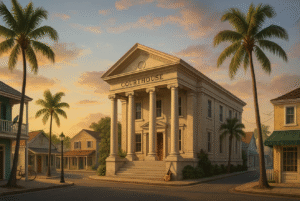The Department of Housing and Urban Development (HUD) has released a comprehensive update to the Manufactured Home Construction and Safety Standards, which affects real estate developers involved in the construction, sale, and management of manufactured housing. Effective March 17, 2025, the final rule incorporates recommendations from the Manufactured Housing Consensus Committee (MHCC) and addresses critical safety, construction, and design elements. Developers in the manufactured housing sector stand to benefit from these changes, particularly in terms of flexibility, modern design standards, and expanded opportunities for multi-unit developments.
Key Highlights for Developers:
1. Fire Sprinkler Systems: Flexibility with Safety HUD’s revised stance on fire sprinkler systems has important implications for developers. Although HUD has not mandated installing fire sprinkler systems in manufactured homes, the rule provides a clear framework for developers who wish to offer this feature voluntarily or in response to state or local regulations. If a developer decides to install a sprinkler system, the testing and certification of water pressure must now be performed by a qualified fire protection technician rather than manufactured home installers.
This shift reduces liability on installers and ensures that the system operates effectively once the home is placed. Developers who operate in jurisdictions with stricter fire safety regulations or who target consumers seeking enhanced fire protection may find this rule beneficial. The new flexibility allows developers to cater to a wider range of buyers without increasing construction costs across the board.
2. Multi-Unit Dwellings: New Opportunities for Development The rule significantly expands the potential for manufactured housing in multi-unit developments by allowing up to four units in a single manufactured structure, up from the previous limit of three. This change makes manufactured housing a more attractive option for developers targeting affordable housing initiatives. Developers can now build small multi-family units using manufactured homes, which allows for quicker construction, reduced material costs, and the ability to meet the demands of growing affordable housing markets. Real estate developers focused on low- to mid-income housing, particularly in urban and suburban areas, can now integrate manufactured housing into multifamily residential zones, increasing their flexibility in land use planning. This creates opportunities for housing developments that meet demand for lower-cost, energy-efficient housing in regions where space and cost are limiting factors.
3. Exterior Door and Accessibility Requirements: A Safer Standard The updated standards for exterior doors emphasize both safety and accessibility. HUD has raised the minimum required width for one of the exterior doors in manufactured homes to 32 inches. This increase ensures that homes meet broader accessibility requirements, allowing easier access for individuals with mobility issues and ensuring that emergency medical personnel can safely and efficiently enter with gurneys or other emergency equipment. For developers, this shift not only increases the marketability of manufactured homes to elderly or disabled buyers but also aligns these homes with federal accessibility standards, which could be a selling point for those catering to buyers utilizing federal programs or subsidies. Additionally, the rule allows for the inclusion of door stops and seals, provided they do not reduce the clear opening of at least one external door. This flexibility allows developers to maintain high energy efficiency standards without compromising safety or accessibility.
4. Adoption of Modern Standards for Windows, Doors, and Roofing: One of the critical updates involves adopting more modern construction standards for components such as windows, doors, and roofing. HUD has incorporated the 2017 version of the AAMA/WDMA/CSA 101 standard, which aligns manufactured homes with advancements in energy efficiency and durability. This is particularly significant for developers who wish to offer homes that meet or exceed energy standards while maintaining affordability.
For real estate developers, including these modern standards enhances the competitiveness of manufactured homes in the market. As homebuyers increasingly prioritize energy efficiency, manufactured homes designed to these specifications can meet buyer expectations while keeping construction costs lower than site-built alternatives.
5. Fire-Resistant Materials and Insulation: Maintaining Safety Without Sacrificing Efficiency Fire safety continues to be a primary focus in the updated standards. The new rule clarifies the use of loose-fill insulation, ensuring that it can be used as long as it does not reduce the fire resistance of walls or ceilings. This is crucial for developers aiming to incorporate sustainable and energy-efficient insulation materials into their projects. Maintaining compliance with fire safety standards while meeting modern energy efficiency goals is now more streamlined, allowing developers to use a wider variety of materials without compromising safety.
Additionally, the updated rule includes fire resistance standards for multi-unit manufactured homes, allowing developers to reduce fire resistance ratings from one hour to half an hour when fire sprinklers are installed in all units. This option provides developers with construction flexibility and offers cost-saving opportunities when fire sprinklers are included. Implications for Real Estate Developers: Flexibility and Cost Savings: The rule introduces more flexible construction standards, which provide real estate developers with cost-saving options in various areas, from fire safety features to energy-efficient designs.
Affordable Housing Potential: With multi-unit capacity expanded to four units, developers now have new opportunities to meet affordable housing demands using manufactured homes, a critical tool in addressing housing shortages in urban and suburban markets.
Marketability: Integrating modern safety and efficiency standards makes manufactured homes more competitive in a market where consumers increasingly seek energy-efficient, safe, and accessible housing options. Developers can market these homes as affordable alternatives to traditional site-built homes while meeting or exceeding consumer expectations.
In conclusion, HUD’s new rules provide developers with expanded opportunities to leverage manufactured housing in innovative ways. With increased flexibility, modern construction standards, and a focus on safety and accessibility, manufactured homes are poised to become a key component of future housing development strategies.
We hope you found this helpful — any feedback is appreciated and can be shared by hitting reply or using the feedback feature below.
-
Was this email forwarded to you? Subscribe here.
-
Have an idea or issue to share? Email us.
-
Connect with us using your preferred social media and website links for MyLandTrustee and Aspire Legal Solutions.
-
Our mailing address: PO Box 547945, Orlando, FL 32854-7945
-
Our physical address: 1901 West Colonial Drive, First Floor, Orlando, FL 32804
Be on the lookout for our next issue! 👋





